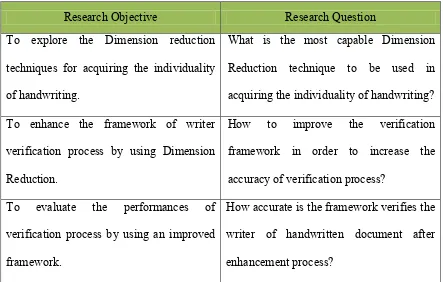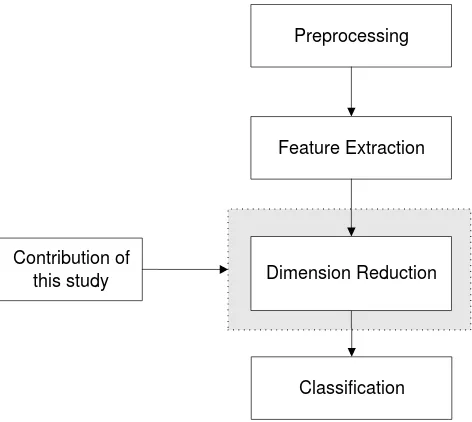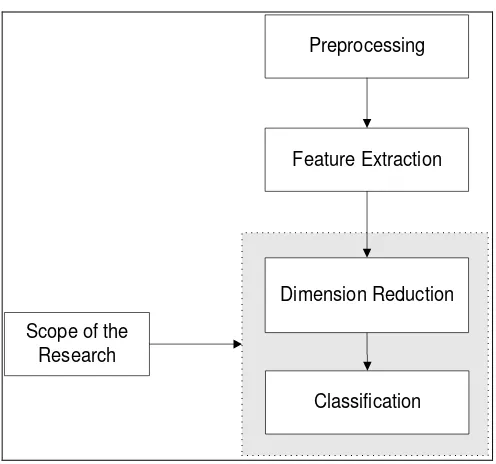Faculty of Information and Communication Technology
PRINCIPAL COMPONENT ANALYSIS – DIMENSIONALITY
REDUCTION FOR WRITER VERIFICATION
Rimashadira Binti Ramlee
Master of Science in Information and Communication Technology
PRINCIPAL COMPONENT ANALYSIS - DIMENSIONALITY REDUCTION FOR WRITER VERIFICATION
RIMASHADIRA BINTI RAMLEE
A thesis submitted
in fulfillment of the requirements for the degree of
Master of Science in Information and Communication Technology
Faculty of Information and Communication Technology
UNIVERSITI TEKNIKAL MALAYSIA MELAKA
DECLARATION
I declare that this thesis entitled “Principal Component Analysis – Dimensionality Reduction for Writer Verification” is the result of my own research except as cited in the references. The thesis has not been accepted for any degree and is not concurrently submitted in candidature of any other degree.
APPROVAL
I hereby declare that I have read this thesis and my opinion this thesis is sufficient in term of scope and quality for the award of Master of Science in Information and Communication Technology.
Signature :... Supervisor Name :Prof Madya Dr. Azah Kamilah Bt Muda Date :...
DEDICATION
In the name of Allah, the Most Gracious and the Most Merciful.
I dedicate this work to:
My Parent:
Ramlee Anak Ahad & Rosenani Abdul Jalil.
My Siblings:
i
ABSTRACT
ii
ABSTRAK
iii
ACKNOWLEDGEMENT
In the name of Allah, the Most Gracious and the Most Merciful. I take this opportunity to express my deep regards and a lot of thanks to my first Supervisor Dr.Azah Kamilah Binti Muda for her guidance, monitoring and constant encouragement throughout the course of this thesis. The blessing, help, and guidance given by her time to time shall carry me a long way in the journey of life on which I am about to start.
I also take this opportunity to thanks my co-supervisor Dr.Burairah Bin Husain, for his support, valuable information and guidance also knowledge that he give me, which help me in completing every task in completing my study.
I appreciation all the staff members of Fakulti Teknologi Maklumat dan Komunikasi, Universiti Teknikal Malaysia Melaka for giving me valuable information in their respective fields. I am grateful for their cooperation during my study.
My special thanks to my parent Ramlee Anak Ahad and Rosnani Abdul Jalil for their constant support and love me all the time. They always stay by my side when I am in disappointment, stressful and bad condition. Their blessings always carry me along the way in the journey of my life.
iv
LIST OF TABLES
TABLE TITLE PAGE
1.1 Relations between Research Objective and Research Question 5
2.1 Groups of Classification Methods 27
3.1 The Example of Sample Data 32
3.2 The relation between Improvement and investigation 34
3.3 The Comparison of PCA and LDA 35
3.4 Result of the Experiment 36
3.5 Comparison Result of Training set Classification 41 3.6 Comparison Result of Chosen Classifier. 42
3.7 Description of the Experimental 50
4.1 Example of the Handwriting Data after Feature Extraction. 57 4.2 Example one of writer Principal Component (PCs) 62
4.3 Summary of Selection Rules 66
4.4 Number of Selected Principal Component 68
5.1 Result of Experiment 75
vi
4.3 PCA Algorithms 64
4.4 Graph Plots of Transformation Data by First Principal Component 67 5.1 New design of Verification Framework. 71
5.2 Experimental Designs 74
vii
LIST OF ABBREVIATIONS
WV - Writer Verification DR - Dimension Reduction
PCA - Principal Component Analysis LDA - Linear Discriminant Analysis PCs - Principal Component
viii
LIST OF SYMBOLS
ix
LIST OF PUBLICATIONS
Ramlee, R., Muda, A. K., and Emran, N. A. 2014. Comparison of Feature Dimension Reduction Approach for Writer Verification. First International Conference on Advanced
Data and Information Engineering, 285, 92-102.
x
2.2.2 Research Issue in Writer Verification 17
2.2.3 Writer Verification Model 18
2.3 Individuality of Handwriting 19
2.4 Dimension Reduction 20
2.4.1 Linear and Nonlinear Dimension Reduction 22
xi
4.1.1 Overview of Principal Component Analysis 54
4.1.2 Operational Procedure of Principal Component Analysis 55
4.2 Modeling of Principal Component Analysis 63
CHAPTER 1
INTRODUCTION
1.0 Research Background
Nowadays, most of people shift toward typing rather than writing. However handwritten paper document still never been forgotten, because handwriting is a basic of normal human being behavior especially in Forensic Science field. Thus, there always have been situations in which unsigned or anonymous writing on documents were potentially important. Thereby, the provision of proof towards the authorship of such documents has long been an issue particularly in handwriting biometric study (Huber and Headrick, 1999). A part from that, this study is proposed to use Handwriting Analysis approach in order to proof the authorship of handwritten document.
Furthermore, handwriting has long been considered as individualistic and unique especially in examining forgery or authenticity of a document. According to (Zhang and Srihari, 2003a) the individualistic and uniqueness of handwriting rests on the hypothesis that each individuals has unique characteristic of handwriting call as individuality of handwriting. Therefore, this individuality becomes a major issue in this study for implementation of handwriting analysis approach (Srihari, 2002). Apart from that, a lot of application such as criminal justice system will use this individuality to verify the author which involve in crime such as black mail, falsification of the will, etc.
2
obtain the individuality of handwriting from the handwritten data of the writer. Henceforth, this study will propose reduction approach for acquire the individuality of handwriting to overcome the major issue in applying handwriting approach. The basic purpose of reduction concept is facing the irrelevant and redundancy problem that occur in a sample data that can influence the data analysis process. Therefore, this irrelevant and redundancy must be eliminated from the data to enhance the representation of data for analysis purposed (Masaeli et al., 2010).
DR is one techniques of the reduction approach the usually used in data analysis process. DR is chosen because of its facilities which effectively transform the original data into new feature space with reduced dimension (Cunningham, 2007). The new feature space consist only the most significant feature of original data which can be used to represent the individuality of handwriting. Reduction that implemented by DR is based on the dimension of the features vector not by each single feature. This is because DR thought that the entire features are important in representing the sample data. However, this technique will select dimension that consist of the best features vector combination which is most significant feature is in there.
3
1.1 Problem Statements
The main purpose of Writer Verification is to verify the author of handwritten document. In order to implement WV method, this study was facing one major issue which is acquiring the individuality of handwriting in order to improve the verification framework. The necessity of individuality of handwriting is a priority in writer verification process (Bensefia et al., 2004; Srihari, 2002; Zois and Anastassopoulos, 2001). Therefore, obtaining the features that can represent individuality of handwriting became a problem in verification process. The features should be unique among the individual features of the writer and significant to clarify the pattern of handwriting data. In order to acquire the features that can represent the individuality on handwriting, Dimension Reduction (DR) approach was chosen to be applied in this study.
4
ii. How to improve the verification framework in order to increase the accuracy of verification process?
iii. How accurate is the framework verifies the writer of handwritten document after enhancement process?
1.2 Research Objectives
Primarily aim of this study is to verify the author of handwritten document by using Writer Verification process. However, acquiring the individuality of handwriting is a major issue in this study. Furthermore, individuality of handwriting is a requirement that can influence the performance of verification process in order to verify the writer. Meanwhile, features that extracted from handwriting image will represent the individuality of handwriting. In addition, among all the features reduction process is needed to select the best feature combination to improved the verification process. Therefore, there are two objectives suggested below in order to overcome the big issue in this study:
i. To explore the Dimension Reduction Techniques for acquiring the individuality of handwriting.
ii. To enhance the framework of writer verification process by using Dimension Reduction.
iii. To evaluate the performances of verification process by using an improved framework.
5
Table 1.1: Relations between Research Objective and Research Question
Research Objective Research Question
To explore the Dimension reduction techniques for acquiring the individuality of handwriting.
What is the most capable Dimension Reduction technique to be used in acquiring the individuality of handwriting? To enhance the framework of writer
verification process by using Dimension Reduction.
How to improve the verification framework in order to increase the accuracy of verification process?
To evaluate the performances of verification process by using an improved framework.
How accurate is the framework verifies the writer of handwritten document after enhancement process?
1.3 Research Hypothesis
The hypothesis of this study is: “The proposed new frameworks by inserting Dimension Reduction techniques into previous verification framework will be able to acquire the individuality of handwriting by reducing the dimension of the features and improving the classification performance of Writer Verification.”
1.4 Research Contribution
6
verification framework by using Dimension Reduction technique. The purpose of enhancement the framework is to improve the accuracy of verification process into 100 % can prove the writer of the handwritten document.
As mention in Problem Statement, individuality of handwriting was become a big issues in most of handwriting analysis research field. Most of previous research was focus in solving this issue either in writer identification or writer verification (Bensefia et al., 2004; Zhang et al., 2003b; Zhang and Srihari, 2003a; Srihari, 2002; Zois and Anastassopoulos, 2001). Therefore, the first step will conducted in this study is exploring the DR techniques that capable in acquiring the significant or important feature that can represent the individuality of handwriting. However, the most important step is to enhance the verification framework by injecting the DR technique into the framework as one of the process before conducting the classification process. In the end of the process, the evaluation of framework performance will be conducted by using classification accuracy.
Feature Extraction Preprocessing
Classification Contribution of
this study Dimension Reduction
7
1.5 Research Scope
The research scope of this study can be divided into three determinations. There are selecting the methods to formulate a framework improvement, data source and type of measurement use to compare the result. However, the major interest is development of DR Techniques and the implementation of it into previous verification framework of WV. Therefore, this study will begin by exploring the suitable methods in conducting DR task until the end of WV process which is classification task.
The first determination is to select the method to perform DR task and classification task. The purposed of DR task is to reduce the irrelevance feature without losing much information of the writer. Hence, DR approach is capable to be used in constructing the new design of WV framework. While, only one classifier will be choose after conducting some experiment for classification task to perform verification process.
The sample data is collected from IAM Handwriting Database (Marti and Bunke, 2002), where the original data that stored in the database are images. Firstly, images need to be converted into a numeric type of data before use it in the experimental. Moreover, only five writers with 3619 instances of images are chosen from 657 writers that contribute their handwriting samples. On the other hand, each writer has nine samples handwritten documents which contain more than one thousand words. Only five writers are chosen because of there is a difficulties to collect the writer has more than nine of their handwritten documents.


